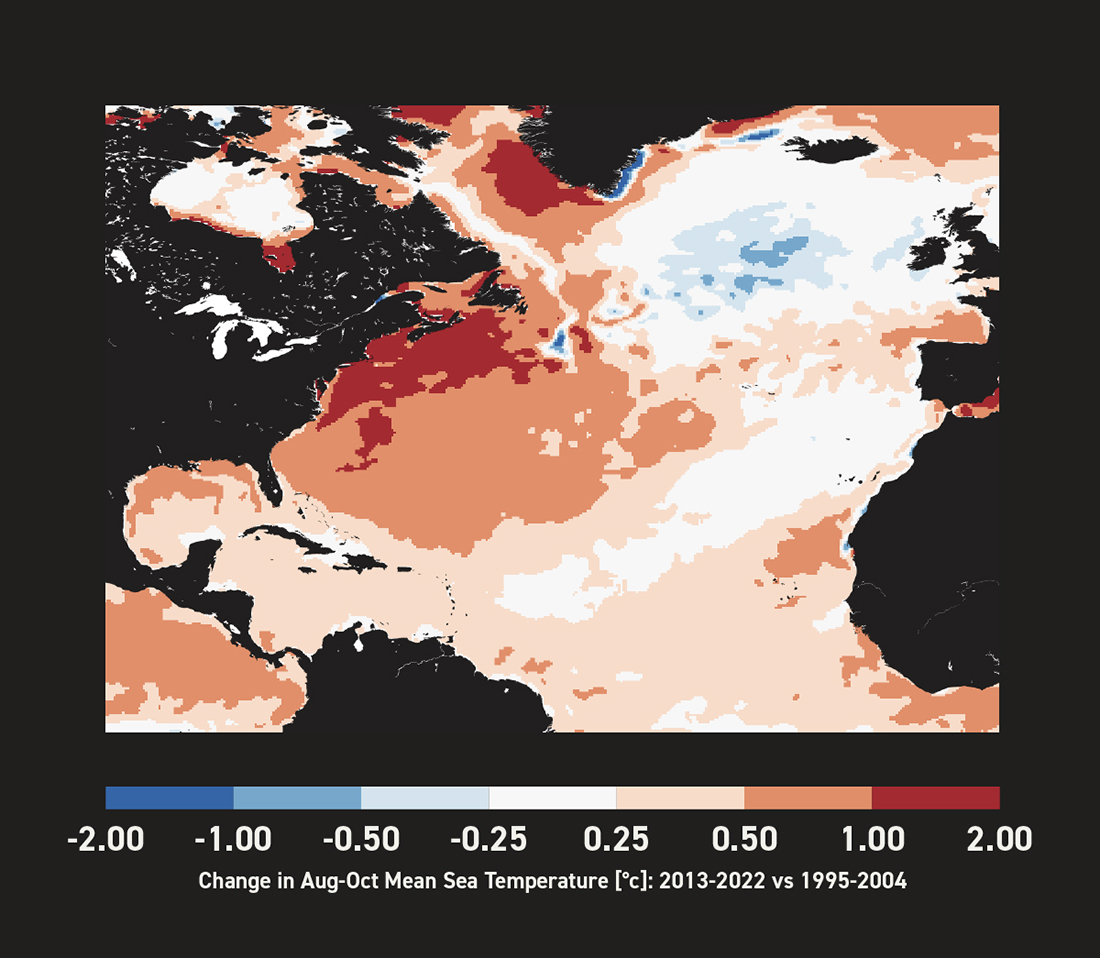
There was a sense of foreboding at the start of the hurricane season. La Nina was present, and seasonal forecasts spoke of much-above-average hurricane activity. Now, with the end of the hurricane season upon us – in spite of the sizeable losses from Hurricane Ian – the season fell short of the promised upper-teens tropical storm count.
Rather than perform a post-mortem of ‘what went wrong?’, let’s look at how hurricane seasons shape up in the present day compared to previously. We’ll also use a few examples to explore why – despite a fairly average season for hurricane numbers – the current climate is maybe a little different to the past.
The one certainty is that a warm sea is a necessary condition for hurricanes to form and be supported. But how we explain our present warm seas could potentially impact how we perceive the present-day risk in the light of the latest science. A lot of it lies in the interpretation of the Atlantic Multidecadal Oscillation (AMO) – used historically to explain the see-sawing of Atlantic Sea temperatures in the regions hurricanes can inhabit.
This chart shows the AMO Index taken from NOAA’s Physical Sciences Laboratory.

The numbers relate to North Atlantic sea temperature anomalies in the region where tropical cyclones can exist. Positive numbers point to a warm phase of the AMO. What strikes you first is the see-sawing behaviour of this ‘oscillation’. The second point of note is that 2022’s value is the highest on record.
There are two schools of thought indicated on the graph:
- The traditional viewpoint that the AMO oscillates and we’re due to move back into a cooler phase at some point.
- A more recent theory that the cold phase of AMO in the 1960s to 1980s is driven by human activity and aerosol emissions.
Point 2 revises work done 20 years ago by the same scientist who coined the term AMO in point 1, so represents, in essence, a potential advance in understanding.
Regardless of which theory you believe, the other interesting element to this data is that the background warming of the atmosphere seemingly means present-day hurricane seasons are occurring under warmer seas than the previous AMO ‘warm phase’ of the 1940s-50s. This needs to be given careful consideration when building a view of risk.
Digging deeper, we can even see how sea surface temperatures have continued to rise within the current ‘warm phase’ of the AMO since 1995. The chart below highlights the August-October mean sea surface temperature difference between two 10-year chunks – 1995-2004 and 2013-2022 – essentially representing both the start of, and today’s, current warm sea period.

The warm colours suggest the seas are continuing to warm throughout this ‘warm phase’, especially close to the eastern seaboard of the US. This again underscores the importance of understanding things very much in the present day when it comes to Atlantic hurricane risk.
However, the background warming of the earth is just one element to understanding how risk fluctuates over time. Much shorter-timescale global atmospheric variability is arguably more important in understanding risk on a year-by-year basis, compared to the slower, background creep of climate change.
The chart below shows the tropical storm basin count from 6,000 years of climate model simulations in different phases of the El Nino Southern Oscillation (ENSO) – a variability in the Pacific Equatorial sea temperature that influences global weather patterns.

What is evident from this data is the seemingly subtle impact this variability in the atmosphere has on Atlantic Hurricane seasons. During a La Nina, the chance of a more hyperactive season increases, while an El Nino increases the chance of a quieter season. Although 2022’s forecasted busy season didn’t necessarily occur, you can see an average season is still likely during La Nina.
However, change the diagnostics to look more at the extremes, and the differences can be a little starker:

The chart shows how, in the mean, the statistics are unremarkable – at least in the eyes of the climate model. The average storm count shifts slightly in El Nino/La Nina years. However, if we start looking at the more extreme years – the quiet or hyperactive seasons – the role of this natural variability comes more to the fore.
The eye-opener is the impact of El Nino/La Nina on the return period of ‘hyperactive’ seasons (defined here as 20 or more storms) – respectively doubling or halving the return period of this type of season.
True, we’ve had our heads turned by climate change in recent years, but we simply cannot take our eye off the natural variability exhibited in the atmosphere and its impact on short-term risk – especially tail risk, which those of us in catastrophe modelling are here to understand.
As we attempt to navigate the relatively young scientific state of climate change’s role in catastrophe risk, all potential sources of hazard uncertainty should be considered.
At Inigo we want to stand out from the crowd by continually developing our understanding of the hazards that create risk. We are not afraid to challenge conventional views with differing perspectives. We fundamentally believe in the importance of continually equipping our underwriting team with as much information as possible regarding the current state of science and risk.
“In the hurly burly of the renewal season it is helpful to be reminded that we should not be overly distracted by what happened ‘last week’. Rather, that there is a much to learn from a sober contemplation of truly long-term trends. Great to have these insights thoughtfully brought to life – thanks Richard.”
Russell Merrett


